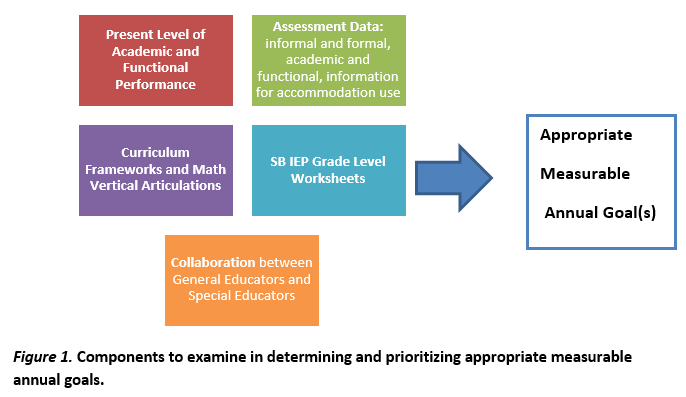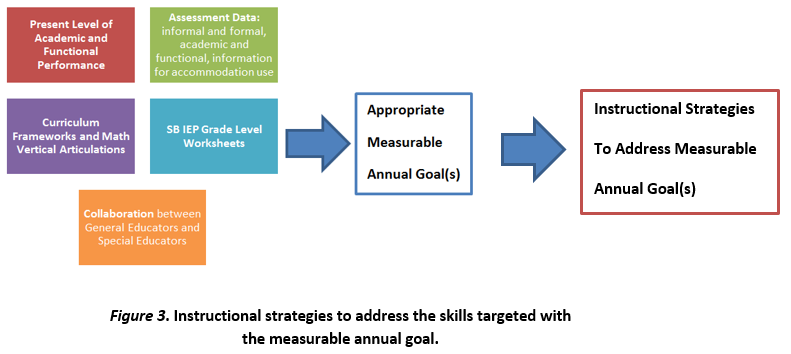Updated by Debbie Grosser, Ed.D. and Susan Jones, M.Ed.
In 2011, the Virginia Department of Education (VDOE) introduced Standards-Based Individualized Education Programs (SB IEPs). As a result of the Dear Colleague letter issued by the Office of Special Education and Rehabilitative Services in November, 2015, VDOE updated its guidance document (March, 2016). As noted in this document, all students eligible for special education services are required to have SB IEPs “to ensure that children with disabilities are held to high expectations and have meaningful access to a State’s academic content standard” (p. 9). Use of SB IEPs is viewed as a mechanism for moving students with disabilities forward to on-time graduation with a standard diploma. The focus is on increasing access to the general education curriculum as defined by the Virginia Standards of Learning (SOL), as well as providing specialized instruction to address need areas, including functional and basic skills.
SB IEPs differ from traditional Individualized Education Programs (IEPs) mainly in the depth and breadth of information concerning the student’s grade-level content achievement contained within the Present Level of Academic and Functional Performance (PLAAF, often referred to as the Present Level of Performance or PLoP) and the focus of the annual measurable goals. Consideration of the assessment data, whether formal or informal, and information addressing the seven critical questions recommended for consideration within the SB IEP PLoP is necessary to accurately determine and prioritize the goals that will be included in the SB IEP. Collaboration between general educators and special educators to determine strengths and weaknesses relative to the grade-level standards will provide further information regarding prioritizing target skills that need to be addressed with accommodations or with a goal for specialized instruction. Knowledge of the standards and use of the Curriculum Frameworks and Vertical Articulations and the SB IEP worksheets provide the basis for strategic decision-making in selecting appropriate measurable annual goals.

Questions to consider in developing measurable annual goals: (p. 18, SB IEP Guidance Document):
- What are the student’s needs as identified in the Present Level of Performance?
- What skills does the student require in order to master the content of the curriculum?
- What can the student reasonably be expected to accomplish in one school year?
Further guidance of the process is outlined on page 20 of the SB IEP Guidance Document.
For a student whose PLoP indicates that he or she will need significant supports and simplifications to master the grade-level skills and content, the academic goals will address need areas that currently impede mastery of the prioritized grade level skill. Assessment data information and additional components will be synthesized with the Essential Knowledge and Skills of the appropriate Curriculum Framework to determine the prioritization of the academic goals, as outlined in Figure 1.
An example SB IEP PLoP for Jordan, a rising fourth grader with significant support needs, posted on the VDOE SB IEP website, contains the following statements:
“The IEP team has considered the use of goals and objectives in his current IEP and feels that a combination of both best meets his academic needs. However, at this time, the IEP team does not feel that he will achieve grade level proficiency within the year.”
For a student who does not need significant supports and simplification, the academic goals will again address those skills that impede mastery of the grade-level content as defined by the SOL. In this situation, all of the components necessary to determine appropriate measurable annual goal(s) as identified in Figure 1 come into play.
Another example from the VDOE SB IEP website for Amanda, an eighth grader, demonstrates the process of prioritizing the needs of the student through reviewing assessment data, developing the PLoP, and then applying that information within the worksheet. The statement from the PLoP (see below) indicates areas of difficulty determined from formal and informal assessments that provide information about which areas of the eighth-grade math curriculum will present challenges for Amanda to master.
PLoP Statement:
“She is unable to solve single-step and multi-step problems that involve addition and subtraction with fractions and mixed numbers that include denominators of 12 or less. She is unable to simplify expressions by using the order of operations. Amanda would benefit from additional math instruction and will need more time with concrete models of concepts and procedures before moving to the abstract.”
Figure 2 shows areas identified using the PLoP that will hinder Amanda’s mastery of SOL 8.15 within the math curriculum. The worksheet notes that this difficulty will require specialized instruction, and thus is a goal for mastery. The areas of difficulty that may prevent Amanda from achieving mastery of SOL 8.15 are marked with an “X.” The items checked are from the Curriculum Framework, Essential Knowledge and Skills section. Based on this information, an annual goal with a focus on math SOL 8.15 may be:
“Using concrete materials, pictorial representation and paper and pencil to illustrate the steps performed, Amanda will be able to solve two-step linear equations and inequalities, as measured by classroom assignments, teacher observations, and tests, with 80% accuracy.”
Another example from the VDOE SB IEP website for William, a rising eighth grade student, shows he has an identified weakness in decoding. This weakness is discussed within the PLoP, and, using all of the components outlined in Figure 1, a necessary academic goal was determined to be one that targeted and prioritized an SOL.
PLoP Statement:
“The Slosson Test of Oral Reading, which assesses word recognition and decoding skills, administered on April 26, 2016, indicates decoding skills at the third-grade level. Through teacher observations, it is noted that William is not a fluent reader above the second-grade level. William achieves passing grades when assessments are read aloud and novels or passages in class are in audio format.”
Goal (focus on reading SOL 8.4):
“Using grade-level vocabulary, William will use affixes and knowledge of word origins to construct and decode words with 80% accuracy, as measured by teacher-constructed assessments within one year’s time.”
Further, due to an identified strength in the use of technology and the identified decoding weakness, an accommodation of digital text will be used within the general education classroom, while specialized instruction will focus on constructing and decoding vocabulary.
All measurable annual goals are to contain the five components identified as critical for a well-written goal: student, timeframe, conditions, behavior, and criterion (p. 20 of the SB IEP Guidance Document).

A critical next step will be the selection of appropriate instructional strategies (see Figure 3) to address William’s targeted needs within the general education curriculum using specialized instruction provided by the special educator. Strategies that may be used to address William’s targeted need are discussed in the article “Teaching Morphology: Enhancing Vocabulary Development and Reading Comprehension” (Stowe) in the WM TTAC Newsletter, September/October 2011. Further information related to provision of specially designed instruction to address IEP goals will be addressed in the next edition of Link Lines.
Additional Resources
VDOE’s Math Curriculum Frameworks
VDOE’s English Curriculum Frameworks
References
Commonwealth of Virginia Department of Education Standards-Based Individual Education Plan website: http://www.doe.virginia.gov/special_ed/iep_instruct_svcs/stds-based_iep/index.shtml
Standards-Based Individualized Program (IEP): A Guide for School Divisions. (2016). Commonwealth of Virginia Department of Education. http://www.doe.virginia.gov/special_ed/iep_instruct_svcs/stds-based_iep/stds_based_iep_guidance.pdf
Stowe, M. M. (2011, September/October). Teaching morphology: Enhancing vocabulary development and reading comprehension. Link Lines Newsletter. Williamsburg, VA: The College of William and Mary Training and Technical Assistance Center. (This article has been removed.)




